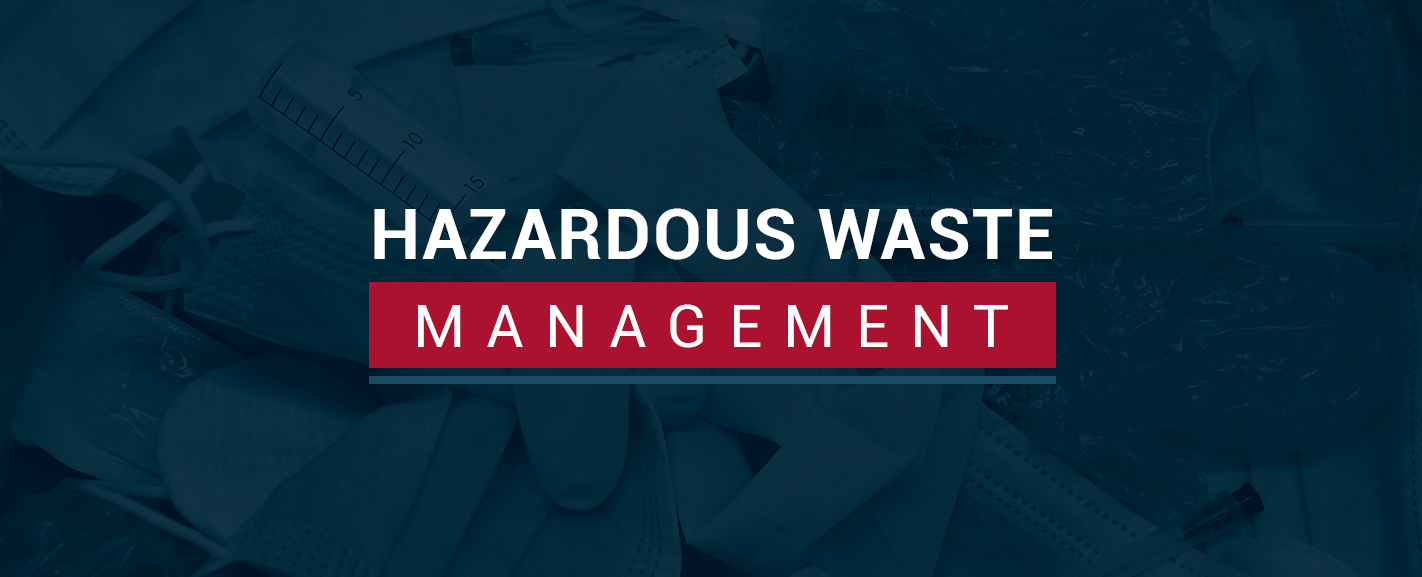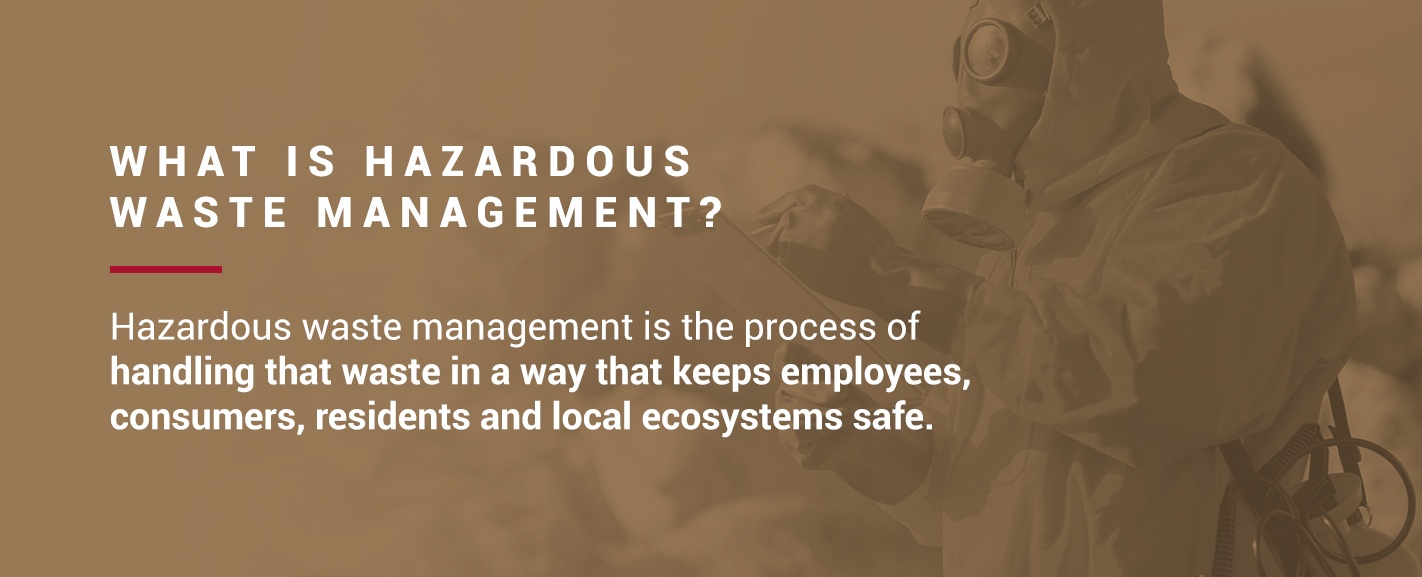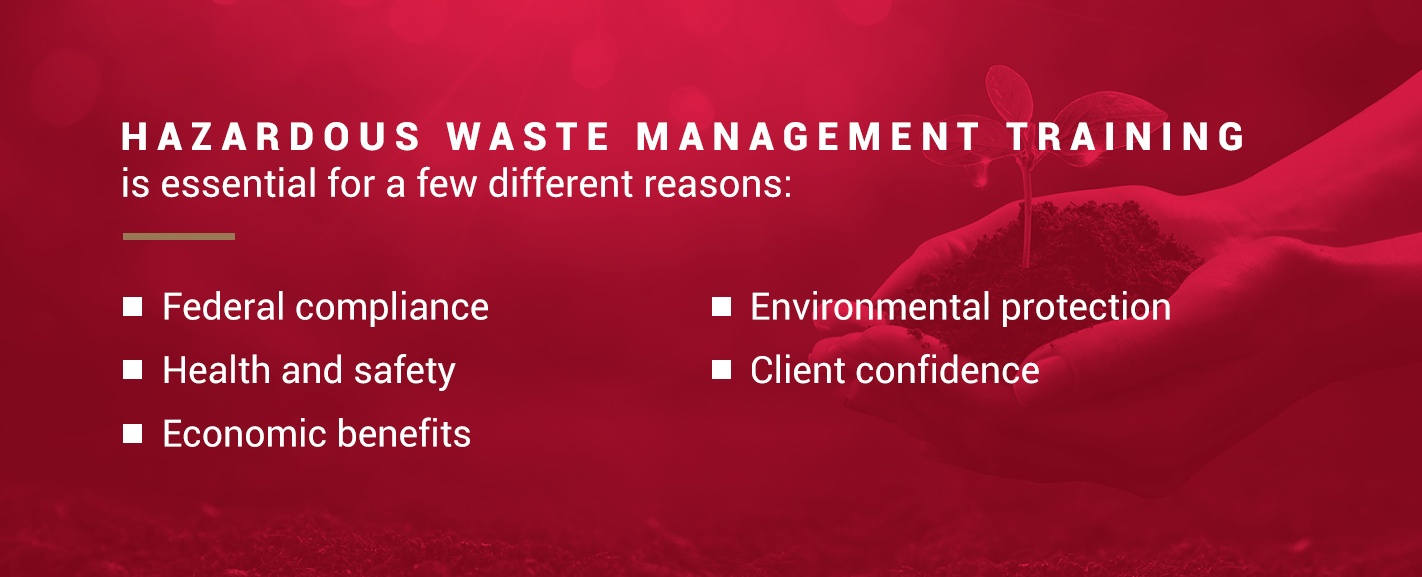Hazardous Waste Management

Jump To:
- What Is Hazardous Waste Management?
- Topics Covered in Our Hazardous Waste Management Training
- Why Hazardous Waste Management Training Is Important
- Benefits of Hazardous Waste Management Training
- Hazardous Waste Management Training
Industries in the United States produce enormous quantities of hazardous waste every year. According to the U.S. Environmental Protection Agency (EPA), in 2017, over 25,000 active large-quantity waste generators created 35.1 million tons of hazardous waste. And small-quantity generators added even more.
Facilities should train employees in hazardous waste management annually to prevent spills and injuries and minimize environmental and public health risks. Here, we discuss hazardous waste management in more detail and explain why a hazardous waste management training course can be so beneficial.
Hazardous Waste Management Training Course
What Is Hazardous Waste Management?
Hazardous waste is waste that could harm the environment or human health. It can come from many sources. Much of it comes from chemicals manufacturing, pharmaceuticals manufacturing and wastewater treatment, but everyday items like some batteries, light bulbs, cleaners, paints and solvents can also constitute hazardous waste. Hazardous waste management is the process of handling that waste in a way that keeps employees, consumers, residents and local ecosystems safe.
Under the Resource Conservation and Recovery Act (RCRA) of 1976, the EPA has the authority to regulate hazardous waste from the cradle to the grave — that is, from the moment of the waste’s generation through its storage, transport and ultimate disposal. Whether the waste has elements that can be recycled, goes to a facility for treatment or goes immediately for disposal in a secure lined landfill, it requires safe and responsible management to avoid severe harms.
The chain of responsibility for hazardous waste management generally passes through a few different facilities: generators, transporters, and treatment, storage and disposal facilities.
- Generators: Generators are the facilities that initially create the waste. These may be industrial plants, manufacturing facilities or businesses that discard items that contain hazardous materials. Some large-quantity generators treat and dispose of their own hazardous waste, but many send it to other facilities.
- Transporters: Transporters are the companies responsible for taking the waste from one facility to the next. They may go straight from the generator to the disposal facility or stop at a transfer facility for storage.
- Treatment, storage and disposal facilities (TSDFs): Treatment, storage and disposal facilities either dispose of waste or help prepare the waste for disposal. These might be recycling centers, chemical or biological treatment centers, landfills, incinerators or other similar facilities.
Topics Covered in Our Hazardous Waste Management Training
Hazardous waste management can be an intricate and challenging process. Fortunately, specialized training courses offer access to helpful tools. At the National Association of Safety Professionals (NASP), we offer unique hazardous waste management specialist (HMS) training to provide waste management facilities with the knowledge and skills they need for success.
In our training courses, we cover topics like these in-depth:
- Detecting, storing and transporting hazardous waste properly
- Drafting emergency procedures
- Complying with hazardous waste disposal restrictions
- Current regulatory requirements
- Hazardous waste exclusions and exemptions
- Regulations governing universal waste
- Volatile organic compound (VOC) standards
- Waste reduction requirements
Students can take up to six months to complete the hazardous waste management specialist course. The course culminates with an online exam, which students can take twice if necessary. Passing the exam with a grade of 80% or higher earns an official certificate in hazardous waste management. To maintain their credentials, students must recertify every three years. This course also meets your annual RCRA requirements for LQGs of hazardous waste. NASP is available for discounted pricing and can make this training site-specific for groups of ten (10) or more.
NASP’s Hazardous Waste Management Training
Why Hazardous Waste Management Training Is Important
Hazardous waste management training is essential for a few different reasons:
- Federal compliance: Hazardous waste management training helps facilities meet federal regulations for hazardous waste management and avoid costly fines. NASP training meets or exceeds the Occupational Safety and Health Administration (OSHA) requirements for health and safety in the workplace.
- Health and safety: Proper hazardous waste management training is crucial for keeping people safe around hazardous waste. Proper training helps protect employees on the job, and it also helps protect the public from dangerous leaks and spills.
- Environmental protection: Hazardous waste management training helps ensure the safety of the environment as well. Hazardous waste discharges could disrupt ecosystems and kill wildlife, but proper management practices help protect against these tragic occurrences.
- Economic benefits: Hazardous waste discharges can be exceptionally expensive, both because of cleanup costs and fines and because of losses that may result from the company’s diminished reputation. Hazardous waste management training helps avoid costly discharges and keep company profits high.
- Client confidence: A certificate through our training courses is an excellent way to signal to clients that you have the skills, knowledge and experience necessary to handle hazardous waste safely and in compliance with federal regulations.
Benefits of Hazardous Waste Management Training
NASP hazardous waste management training offers numerous valuable advantages:
- Convenience: Taking hazardous waste management training online offers convenience and flexibility. Our online opportunities mean students can complete the course at their convenience over six months or less. The online exam is easy to fit into busy schedules as well.
- Genuine interactive learning: Waste management training doesn’t have to involve rote memorization that students will forget once they walk out the door. NASP’s courses incorporate a unique learning management system that provides an interactive learning process through the use of introductory videos, activities, review games and links to external learning material.
- Engagement and retention: The interactive course features help increase student retention so safety is at the forefront of everyone’s mind. Our e-learning courses combine a multimedia approach — state-of-the-art video with rich graphics, fun and challenging games and comprehensive testing to ensure student retention.
- Safety culture: Hazardous waste management training helps companies focus on building a genuine safety culture versus simple regulatory compliance.
- Broad applicability: Hazardous waste manager training is ideal for environmental health and safety (EHS) professionals in all industries, including manufacturing, construction, oil and gas, service industries, the federal government and municipal services.
- Career development: Our certificates aid students in career development, obtaining better-paying jobs and positioning themselves for higher salaries within their current jobs.
- Relevance: The NASP method of EHS training emphasizes andragogical methodologies — educational methods for adults — for interactive and dynamic training that stimulates student interaction and ensures knowledge retention. NASP training is built for, and by, safety professionals and is highly relevant to the modern hazardous waste management workforce.
Contact NASP for All Your Hazardous Waste Management Training Needs
To see the benefits of professional hazardous waste management training for your organization, partner with NASP. We set ourselves apart from the competition with the comprehensive content of our courses, our practical approach to workplace safety, our IACET accreditation for continuing education units (CEUs) and our well-established presence in the educational landscape, both in the United States and worldwide. Our training is built for safety professionals, and we offer an in-depth perspective on how to manage various regulations, plans and programs as a safety professional.
Contact us today to learn more about our practical approach to workplace safety. Click here for any of your site-specific training needs. Often, one course can meet multiple regulatory requirements.
Purchase NASP’s Hazardous Waste Management Specialist Course
Related Posts






